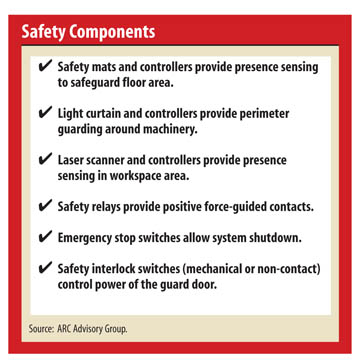Avoiding close encounters between man and machine


The logic for this increased focus on safety is obvious. Packaging lines and work cells that lack an adequate safety environment will simply not be productive. With a broader use of robotics, a greater number of workers are exposed to the robotic workspace than ever before, and the high dynamic forces created with robotic movements can cause severe injuries to humans, as well as damage to machine parts, if unwanted encounters occur between man and machine. Consequently, stringent safety environments must be created and maintained. And the latest robotic safety standards must be designed into work environments.
Significant international development efforts are underway to create strategies for worker safety around automated machinery. In the United States, the revised standard ANSI/RIA R15.06-1999 offers new and improved information for users, system integrators and suppliers of robots. It also specifically addresses existing installations by establishing a minimum level of safety compliance to maintain workers' safety.
The Canadian Standards Association (CSA) has revised its 1994 robot safety standard, which is now based on the US standard. Users who follow this new CSA Z434:2003 standard will comply with the ANSI/RIA R15.06-1999 standard. Thus CSA Z434:2003 has become not only a Canadian, but a North American, standard. (Note: Users who follow ANSI/RIA R15.06-1999 may not fully comply with CSA Z434:2003.)

It is noteworthy that these standards are guidelines, not regulations, so users can decide for themselves how to conform.
To avoid the potential hazards of robotic work cells, designs must be created to maximize safety while optimizing cost-savings. Flexibility and diagnostics must also be considered. For instance, conventional safety relays integrated with perimeter guarding solutions can perform basic tasks, but safety-related buses, programmable safety systems and electronic safety circuits offer greater functionality and lower life cycle costs due to their ease of maintenance, faster installation and reduced downtime.
Good planning, design and installation follow-up, along with active maintenance and support, are essential to the reliability and safety of an overall system. Having the right person to implement a safe robotic work cell is also vital to the process. Therefore, if only limited expertise exists within the manufacturing operation, working with outside consultants should be considered.
Ultimately, however, manufacturers themselves must assume the responsibility for creating a safe area around the robotic workspace, with the primary goal of preventing injuries to the workforce. Unless workers are fully safeguarded, maximal productivity will never become a reality, regardless of how many robots there are on-site.
Looking for a reprint of this article?
From high-res PDFs to custom plaques, order your copy today!





